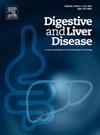联合心脏-肝移植的整体技术:一个繁琐的策略
IF 3.8
3区 医学
Q1 GASTROENTEROLOGY & HEPATOLOGY
引用次数: 0
摘要
背景:单室心脏姑息性方坦样手术后存活的患者越来越多。长期血流动力学改变常导致丰坦相关性肝病(FALD),几乎所有患者都会发生。这些患者发生肝细胞癌(HCC)的风险增加,或者发生严重失代偿性FALD需要肝移植(LT)的风险较低。如果需要,序贯心脏-肝脏移植(CHLT)是最常见的方法,然而,根据很少的科学数据,整体技术具有手术优势,包括更短的器官缺血时间和程序简化。我们的目标是描述在我们中心进行的前两个整体CHLT。方法在2024年,我们中心有2例患者因FALD和心力衰竭而被列入CHLT。我们收集了关于肝移植前处理、手术特征和移植后随访(f/u)的数据。结果病例1:38岁(yo)女性(A血型),先天性大动脉转位,左室发育不全,肺动脉狭窄,窦房结功能障碍,右心室双出口。Glenn和Fontan分别在1岁和7岁时进行心外导管手术(全胸骨切开术3)。17岁时,植入心外膜起搏器。38岁确诊为单灶性HCC (AFP 1042 ng/mL),行立体定向体放疗(SABR)治疗,部分缓解(3、6个月CT扫描,AFP→82→14 ng/mL)。SABR后195天(d),她被列为CHLT。术后46 d行整体CHLT。捐献者年龄27岁。手术时间12小时(h), 8名外科医生参与手术;总缺血时间3.37 h。心脏部分手术在体外循环(CBP)下进行。肝下腔静脉、门静脉总、肝动脉、胆管总重建包括移植物与受体端对端吻合。输血要求:血:6,血浆:600毫升。术后第2天拔管,第6天停用肌力。总住院时间为26天。10个月后,患者存活,未发生HCC复发,方案活检无排斥迹象。病例2:34岁男性(0血型)右心室发育不全并房间隔缺损(ASD)。分别在9岁和15岁时进行Glenn手术和经皮ASD闭合(全胸骨切开术1)。24岁组织学诊断肝硬化,后来出现静脉曲张出血、腹水和肝性脑病。他被列为NaMELD 20和MELD XI 22的CHLT,在上市274天后,他接受了NaMELD 24和MELD XI 23的整体CHLT。捐赠者年龄28岁。手术持续14小时,8名外科医生参与手术。CBP持续225分钟,由于急性右心衰(+肾上腺素,去甲肾上腺素,iNO)升级为ECMO。肝血管及胆道重建包括移植物与受体肝下腔静脉、门静脉、肝动脉、胆管端对端吻合。输血要求:血液单位:6个,血浆:1个,在POD 5时停用ECMO。肝移植功能从一开始就令人满意,尽管有心力衰竭。肺炎克雷伯菌KPC感染性休克发生在POD 5。他接受了肾脏替代治疗(从POD 7到21),气管切开术(POD 13)和POD 33脱管。移植后住院63 d(重症监护室35 d)。f/u 8个月后,患者存活,两种移植物功能良好。结论随着越来越多的Fontan循环患者进入成年期,FALD等并发症越来越普遍。尽管适应症和手术技术尚未标准化,但这一趋势强调了对CHLT专业知识日益增长的需求。根据我们的经验,整体CHLT是一种繁琐但安全有效的策略,减少手术次数和同种异体移植物缺血时间,同时提供移植同种异体移植物的保护。本文章由计算机程序翻译,如有差异,请以英文原文为准。
En bloc technique for Combined Heart-Liver Transplantation: A cumbersome strategy
Background
Patients (pts) surviving after palliative Fontan-like surgery for univentricular heart are arising. Long-term hemodynamic changes often lead to Fontan-associated liver disease (FALD), which develops in almost all pts. These pts are at increased risk for hepatocellular carcinoma (HCC), or less commonly, for severe decompensated FALD requiring liver transplantation (LT). If required, sequential heart-liver transplant (CHLT) is the most common approach, however, according to scanty scientific data, en bloc technique offers surgical advantages, including shorter organ ischemic time and procedural simplification. We aim to describe the first two en bloc CHLT performed at our Center.
Methods
In 2024, in our Center two pts were listed for CHLT due to FALD and cardiac failure. We collected data about pre-LT management, surgical characteristics and post-transplant follow-up (f/u).
Results
Case 1: 38-years-old (yo) woman (blood group A) with congenitally corrected transposition of great arteries, left ventricular hypoplasia, pulmonary stenosis, sinus node dysfunction, right ventricle double outlet. Glenn and Fontan with extracardiac conduit surgeries were performed at age 1 and 7, respectively (total sternotomies 3). At the age of 17, epicardial pacemaker was implanted. At the age of 38, monofocal HCC was diagnosed (AFP 1042 ng/mL) and treated with stereotactic body radiotherapy (SABR), with partial response (CT scan after 3 and 6 months, AFP →82→14 ng/mL). 195 days (d) after SABR, she was listed for CHLT. She underwent en bloc CHLT 46 d after listing. Donor age 27-yo. Surgery lasted 12 hours (h), and 8 surgeons were involved; total ischemia time was 3.37 h. The cardiac portion of the procedure was carried out under cardiopulmonary bypass (CBP). Infrahepatic vena cava, common portal vein, hepatic artery, and common bile duct reconstruction included end-to-end anastomoses between graft and recipient.Transfusion requirement: blood units: 6, plasma: 600 ml. Pt was extubated on post-operative day (POD) 2 and weaned inotropes off by POD 6. The total length of hospital stay was 26 d. After 10 months she is alive, without HCC recurrence, and no signs of rejection on protocol biopsies. Case 2: a 34-yo man (blood group 0) with hypoplastic right ventricle and atrial septal defect (ASD). Glenn procedure and percutaneous ASD closure were performed at 9 and 15 years, respectively (total sternotomy 1). Cirrhosis was histologically diagnosed at 24-yo, later he experienced variceal bleeding, ascites and hepatic encephalopathy. He was listed for CHLT with NaMELD 20 and MELD XI 22 and after 274 d of listing, he underwent en bloc CHLT with NaMELD 24 and MELD XI 23. Donor age 28-yo. Surgery lasted 14 h and 8 surgeons were involved. CBP lasted 225 min and upgraded to ECMO due to acute right heart failure (+adrenaline, noradrenaline, iNO). Hepatic vascular and biliary reconstruction included end-to-end anastomoses between the graft and recipient’s infrahepatic vena cava, common portal vein, hepatic artery, and common bile duct. Transfusion requirement: blood units: 6, plasma: 1 L. ECMO was weaned off on POD 5. Hepatic graft function was satisfactory from the beginning, despite heart failure.Septic shock by Klebsiella Pneumoniae KPC occurred on POD 5. He underwent renal replacement therapy (from POD 7 to 21), tracheostomy (POD 13) and decannulation on POD 33. Post-transplant stay lasted 63 d (35 d in the intensive care unit). After a f/u of 8 months, the pt is alive with excellent function of both grafts.
Conclusion
As more pts with Fontan circulation reach adulthood, complications such as FALD are becoming increasingly prevalent. This trend underscores the growing need for expertise in CHLT, even though indications and surgical techniques are not yet standardized. In our experience, en bloc CHLT is a cumbersome but safe and effective strategy, decreasing operative times and allograft ischemic times, whereas offering protection of implanted allografts.
求助全文
通过发布文献求助,成功后即可免费获取论文全文。
去求助
来源期刊

Digestive and Liver Disease
医学-胃肠肝病学
CiteScore
6.10
自引率
2.20%
发文量
632
审稿时长
19 days
期刊介绍:
Digestive and Liver Disease is an international journal of Gastroenterology and Hepatology. It is the official journal of Italian Association for the Study of the Liver (AISF); Italian Association for the Study of the Pancreas (AISP); Italian Association for Digestive Endoscopy (SIED); Italian Association for Hospital Gastroenterologists and Digestive Endoscopists (AIGO); Italian Society of Gastroenterology (SIGE); Italian Society of Pediatric Gastroenterology and Hepatology (SIGENP) and Italian Group for the Study of Inflammatory Bowel Disease (IG-IBD).
Digestive and Liver Disease publishes papers on basic and clinical research in the field of gastroenterology and hepatology.
Contributions consist of:
Original Papers
Correspondence to the Editor
Editorials, Reviews and Special Articles
Progress Reports
Image of the Month
Congress Proceedings
Symposia and Mini-symposia.
 求助内容:
求助内容: 应助结果提醒方式:
应助结果提醒方式:


